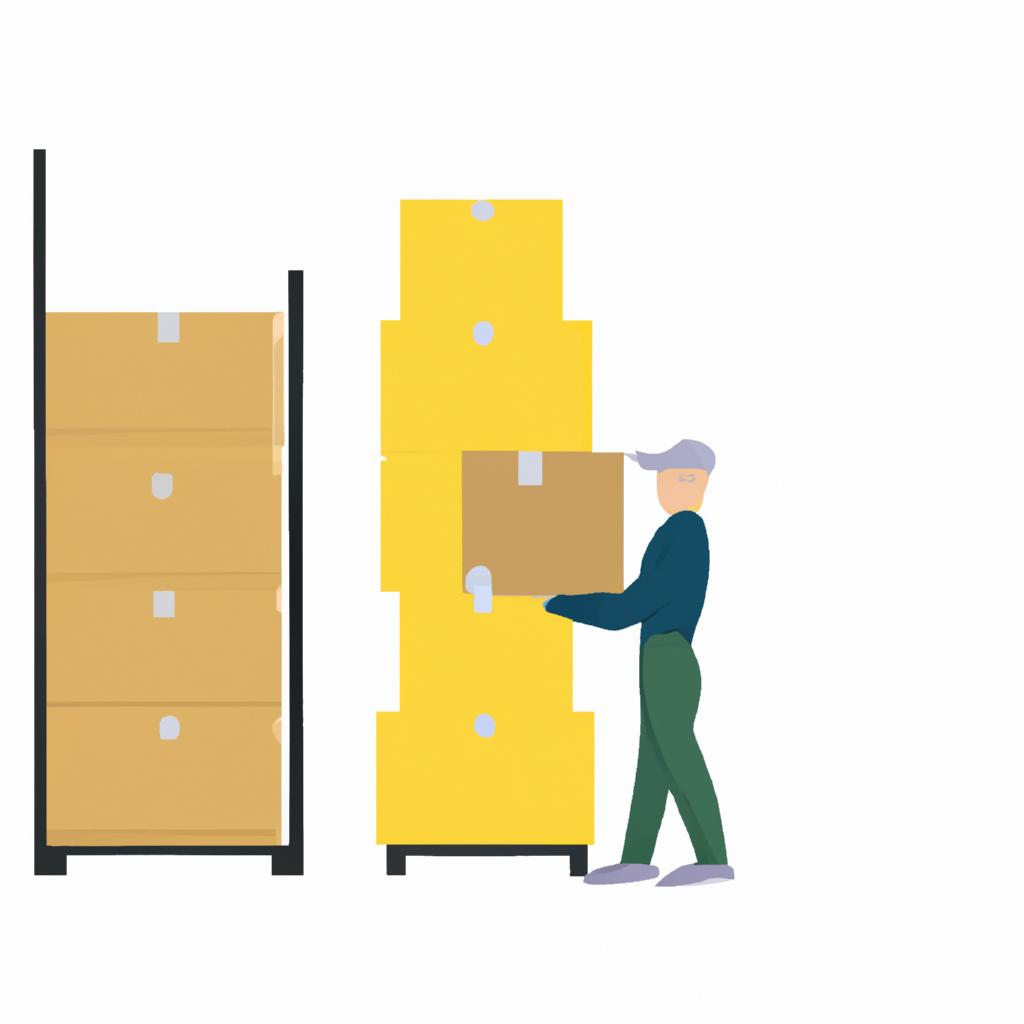Reverse Supply Chain in Transportation and Logistics: Exploring the Power of Reverse Logistics


Reverse supply chain, also known as reverse logistics, is a critical component of transportation and logistics management. It involves the efficient handling and movement of products from their final destination back to their origin or another designated location for various purposes such as recycling, repair, or disposal. This article aims to explore the power and significance of reverse logistics in today’s business environment.
To illustrate the importance of reverse supply chain, let us consider a hypothetical case study. Imagine an electronics manufacturing company that produces smartphones on a large scale. Due to rapid technological advancements, newer models are frequently introduced into the market, making older versions obsolete. As a result, customers often return their outdated smartphones to the manufacturer for proper disposal or refurbishment. In this scenario, effective reverse logistics processes would enable the company to efficiently manage these returned devices by either reclaiming valuable components for reuse or ensuring environmentally friendly disposal methods.
In recent years, organizations have recognized that incorporating reverse supply chain strategies can provide several benefits. Apart from reducing waste and environmental impact through sustainable practices like recycling and remanufacturing, implementing robust reverse logistics systems helps companies recover value from returned products and optimize resource allocation. Furthermore, it enhances customer satisfaction by ensuring prompt resolution of product issues while minimizing costs associated with returns processing and inventory management .
Additionally, reverse supply chain management allows companies to meet regulatory requirements and comply with environmental standards. By properly handling and disposing of products that contain hazardous materials or require special treatment, organizations can mitigate potential legal and reputational risks.
Reverse logistics also plays a crucial role in customer satisfaction and retention. Efficient returns processes, including quick response times, easy return methods, and seamless communication channels, contribute to a positive customer experience. This, in turn, builds trust and loyalty among customers who feel supported by the company even after the initial purchase.
Furthermore, reverse supply chain management enables companies to gather valuable data and insights for product improvement and innovation. By analyzing the reasons for returns, identifying common issues or defects, and understanding customer preferences, organizations can make informed decisions about design changes, quality control measures, or warranty policies.
To effectively implement reverse logistics strategies, businesses need to establish streamlined processes for receiving returned products, inspecting them for quality and condition assessment, sorting them based on their disposition (e.g., recycling or refurbishing), managing inventory levels of refurbished or recycled components/materials, and coordinating transportation back to designated locations.
In conclusion, reverse supply chain management is an integral part of modern business operations. It not only helps companies reduce waste and environmental impact but also recover value from returned products while enhancing customer satisfaction. By embracing robust reverse logistics systems and practices, organizations can optimize resource allocation, comply with regulations, gather valuable insights for product improvement, and build stronger relationships with their customers.
Understanding Reverse Supply Chain
Understanding Reverse Supply Chain
Reverse supply chain, also known as reverse logistics, refers to the process of managing and handling products that flow from the end consumer back to the manufacturer or retailer. This concept has gained significant attention in transportation and logistics due to its potential for cost savings, environmental benefits, and customer satisfaction improvements. To illustrate this concept, consider a hypothetical scenario where a company manufactures electronic devices. When a customer encounters a defect in their purchased device within the warranty period, they initiate a return request. The reverse supply chain comes into play at this point, ensuring that the defective product is efficiently collected, repaired or replaced, and then reintroduced into the forward supply chain.
The importance of understanding reverse supply chain lies in its ability to address various challenges faced by companies operating in today’s competitive market. By effectively managing returns and other forms of reverse logistics activities, organizations can minimize costs associated with unsold inventory and damaged goods while simultaneously reducing waste generation. Moreover, embracing reverse supply chain practices can lead to enhanced customer satisfaction through improved after-sales services and responsive problem resolution.
To highlight some key advantages of implementing a well-structured reverse supply chain strategy:
- Cost Savings: Efficient management of returned products reduces unnecessary expenses related to warehousing space utilization and disposal costs.
- Environmental Sustainability: Proper handling of product returns enables recycling efforts and minimizes landfill waste.
- Customer Loyalty: Effective resolution of customer complaints enhances brand reputation and fosters long-term loyalty.
- Operational Efficiency: Streamlined processes for receiving, inspecting, repairing or refurbishing returned items contribute to overall operational efficiency gains.
Table: Benefits of Implementing Reverse Supply Chain Strategy
| Benefit | Description |
|---|---|
| Enhanced Cost Savings | Reduction in unsold inventory costs; efficient use of warehouse space |
| Environmental Sustainability | Minimization of landfill waste through proper recycling |
| Improved Customer Satisfaction | Prompt resolution of customer complaints; enhanced after-sales service |
| Operational Efficiency | Streamlined processes for handling returns, repairs, and refurbishments |
The understanding of reverse supply chain provides a foundation for exploring the benefits it offers to companies in transportation and logistics. By effectively managing product returns and other forms of reverse logistics activities, organizations can optimize their operations while addressing environmental concerns and enhancing customer satisfaction. In the subsequent section, we will delve into these advantages further and examine how they contribute to the success of businesses adopting reverse supply chain practices.
Benefits of Reverse Supply Chain
Exploring the Power of Reverse Logistics
In today’s ever-evolving business landscape, the concept of a reverse supply chain has gained significant attention. Reverse logistics refers to the management of products moving in the opposite direction of traditional supply chains, from consumers back to manufacturers or suppliers. This section aims to delve deeper into the power and potential benefits that reverse logistics brings to transportation and logistics industries.
To illustrate the impact of reverse logistics, let us consider a hypothetical scenario involving an e-commerce company specializing in electronics. Suppose a customer purchases a laptop online but later discovers it has a defective keyboard upon delivery. In this case, the customer would initiate a return process, triggering the implementation of reverse logistics. The laptop is then sent back to the retailer for inspection and repair before being reintroduced into inventory or resold as refurbished.
The benefits derived from incorporating reverse logistics practices are numerous and can vary depending on industry specifics. Here are some key advantages:
- Cost savings: By effectively managing returns, companies can reduce costs associated with product replacements, storage space requirements, disposal fees for unsellable items, and more.
- Enhanced customer satisfaction: A well-implemented reverse supply chain ensures prompt handling of returns and quicker resolution of customer issues, leading to improved overall customer experience.
- Environmental sustainability: Implementing efficient reverse logistics processes reduces waste generation by refurbishing or recycling returned goods instead of disposing of them entirely.
- Increased brand reputation: Companies that prioritize sustainability initiatives through effective reverse supply chains portray their commitment towards environmentally conscious operations, positively impacting their brand image.
| Benefit | Explanation |
|---|---|
| Cost savings | Efficiently managing returns helps decrease expenses related to product replacement and disposal fees |
| Enhanced customer satisfaction | Quick resolution of customer issues leads to higher levels of overall customer satisfaction |
| Environmental sustainability | Emphasizing refurbishment and recycling minimizes waste generation |
| Increased brand reputation | Prioritizing sustainability initiatives positively impacts brand image |
As we have explored the benefits of reverse logistics, it becomes evident that implementing these practices can significantly transform transportation and logistics operations. In the subsequent section, we will delve into the challenges faced by organizations when incorporating reverse supply chains and discuss strategies to overcome them effectively. By addressing these obstacles head-on, companies can unlock the full potential of reverse logistics in their pursuit of efficiency and sustainable growth.
Challenges in Implementing Reverse Supply Chain
Benefits of Reverse Supply Chain
Reverse supply chain, also known as reverse logistics, plays a crucial role in the transportation and logistics industry by managing the flow of products from their final destination back to their point of origin. In this section, we will explore some of the challenges that organizations face when implementing a reverse supply chain.
One common challenge is the complexity involved in managing returns and product recalls. For example, let’s consider a hypothetical scenario where an automobile manufacturer receives multiple vehicles with manufacturing defects. Implementing a reverse supply chain would enable them to efficiently handle these returns, identify the root cause of the defect, and take necessary actions to prevent its recurrence. This not only saves costs associated with customer dissatisfaction but also helps maintain brand reputation.
Implementing a successful reverse supply chain can yield several benefits for organizations. These include:
- Improved customer satisfaction: By providing efficient return processes and quick issue resolution, companies can enhance customer experience and build long-term relationships.
- Cost savings: Effective management of returned products allows organizations to recover value from those items through refurbishment or resale, reducing overall operational costs.
- Environmental sustainability: Reverse logistics promotes environmental responsibility by facilitating recycling, remanufacturing, or proper disposal of end-of-life products.
- Enhanced forecasting and demand planning: The data collected during reverse logistics operations provides valuable insights into consumer behavior and market trends, enabling more accurate demand forecasting.
To better understand these benefits, refer to the following table showcasing real-world examples:
| Benefit | Example |
|---|---|
| Improved Customer Satisfaction | A clothing retailer offering hassle-free return policies |
| Cost Savings | An electronics manufacturer refurbishing returned smartphones |
| Environmental Sustainability | A furniture company repurposing old materials into new designs |
| Enhanced Forecasting and Demand Planning | A technology firm using return data to predict future product demand |
In conclusion, implementing a reverse supply chain offers numerous advantages for organizations in the transportation and logistics industry. By effectively managing returns, companies can improve customer satisfaction, reduce costs, contribute to environmental sustainability, and enhance their demand planning capabilities.
Next, we will explore key strategies for implementing an effective reverse supply chain that maximizes these benefits while overcoming potential challenges.
Key Strategies for Effective Reverse Supply Chain
Title: ‘Reverse Supply Chain in Transportation and Logistics: Exploring the Power of Reverse Logistics’
Previous section H2: ‘Challenges in Implementing Reverse Supply Chain’
Next section H2: ‘Key Strategies for Effective Reverse Supply Chain’
Transition from previous section:
Having discussed the challenges faced while implementing a reverse supply chain, it is now imperative to explore key strategies that can enhance its effectiveness. To illustrate these strategies, let us consider an example where a major e-commerce company successfully implemented reverse logistics processes to handle customer returns efficiently.
Section: Key Strategies for Effective Reverse Supply Chain
One such strategy involves establishing clear guidelines and policies for handling returned products. By creating well-defined procedures, companies can streamline their reverse logistics operations and ensure consistency across all levels. For instance, our case study found that this e-commerce company developed comprehensive return policies that guided customers on how to initiate returns and provided specific instructions regarding product condition requirements. These policies were communicated clearly through multiple channels to maximize awareness among both customers and employees.
To effectively manage the complexities of a reverse supply chain, another important strategy is collaboration with external partners. This entails building strong relationships with suppliers, manufacturers, distributors, and even competitors within the industry. In doing so, companies gain access to valuable resources such as shared transportation networks or consolidation centers which facilitate optimized routing of returned goods. Moreover, collaborating with stakeholders enables companies to tap into their expertise and leverage synergies throughout the entire supply chain network.
Embracing technology plays a crucial role in enhancing efficiency within a reverse supply chain. Companies can utilize advanced tracking systems that provide real-time visibility into returned products’ status and location. Additionally, integrating data analytics tools allows businesses to analyze patterns related to product returns and identify opportunities for process improvement. Our case study revealed that by leveraging sophisticated software solutions combined with IoT devices installed in transit vehicles, the e-commerce company was able to collect valuable data on return volumes, reasons for return, and transit times. This enabled them to identify bottlenecks and implement proactive measures to minimize return costs.
To summarize, key strategies for effective reverse supply chain management include establishing clear guidelines and policies, fostering collaboration with external partners, and embracing technology solutions. These strategies enable companies to optimize their operations, enhance visibility, and reduce costs associated with managing returned products. In the subsequent section, we will delve into various technological solutions that can further revolutionize the implementation of a reverse supply chain network.
Transition: With an understanding of the key strategies in place, let us now explore the role of technology solutions in optimizing a reverse supply chain network.
Technology Solutions for Reverse Supply Chain
Technological advancements play a crucial role in optimizing reverse supply chain processes. From tracking and tracing to data analytics, various technologies have emerged as key enablers of efficient reverse logistics. For instance, let’s consider the case study of Company X, a leading e-commerce retailer that implemented advanced technology solutions to enhance its reverse supply chain operations.
To begin with, one significant technological solution is the implementation of real-time visibility systems. These systems allow stakeholders to track returned products from initiation to final disposition. By leveraging RFID tags or barcodes, companies can accurately monitor the movement of goods throughout the entire reverse supply chain process. This level of transparency enables better decision-making and reduces inefficiencies associated with product returns.
Furthermore, data analytics tools are instrumental in driving improvements within the reverse supply chain domain. With vast amounts of data generated at each stage of the process, organizations can leverage advanced analytics algorithms to gain valuable insights into patterns and trends. These insights help identify root causes of returns, improve inventory management strategies, optimize routing decisions, and even predict potential return issues before they occur.
In addition to real-time visibility and data analytics, automation technologies also contribute significantly to streamlining reverse supply chain operations. Automated sorting systems assist in efficiently categorizing returned products based on their condition and disposition options such as refurbishment or resale. Additionally, robotics and artificial intelligence-based solutions facilitate faster inspection processes by identifying defects or damages more accurately than manual inspections.
The integration of these technology solutions presents several benefits for companies engaged in reverse logistics:
- Improved operational efficiency
- Enhanced customer satisfaction through quicker resolution times
- Reduction in costs associated with handling returns
- Minimization of environmental impact by enabling proper disposal methods
| Benefits |
|---|
| Improved operational efficiency |
| Enhanced customer satisfaction |
| Cost reduction |
| Environmental impact minimization |
Embracing technology-driven solutions empowers businesses across industries to effectively manage complex reverse supply chain networks. However, it is essential to consider that the adoption of these technologies requires careful planning and investment to reap their full potential.
In light of the significant impact technology has on the reverse supply chain landscape, exploring future trends becomes crucial in staying ahead of industry developments. In the following section, we will delve into emerging trends and advancements that are set to shape the future of reverse logistics.
Future Trends in Reverse Supply Chain
Section: Exploring the Benefits of Technology Solutions for Reverse Supply Chain
Transitioning from the previous section, where we discussed the significance of technology solutions in reverse supply chains, let us delve further into their benefits. To illustrate this, consider a hypothetical case study involving a global e-commerce company that specializes in selling electronic devices. Facing an increase in customer returns due to product defects and order cancellations, the company implemented a comprehensive technology solution for its reverse supply chain.
One key benefit of utilizing technology solutions in reverse supply chains is enhanced visibility and traceability. By implementing real-time tracking systems and advanced data analytics tools, companies can closely monitor each stage of the return process. This enables them to identify bottlenecks or inefficiencies promptly and take appropriate actions to streamline operations. In our hypothetical case study, the e-commerce company used RFID tags on returned products to track their movement through various stages such as inspection, repair, refurbishment, and resale. The real-time access to information allowed them to optimize inventory management and reduce cycle times.
Implementing technology-driven solutions also offers improved decision-making capabilities. With access to accurate and up-to-date data on returns patterns, reasons for return, and customer feedback, companies can make informed decisions regarding product quality improvement initiatives or changes in packaging design. For instance, by analyzing data from customer returns collected through an online portal integrated with their system, the e-commerce company was able to identify recurring issues with one particular model of smartphones they were selling. Armed with this knowledge, they collaborated with their suppliers to rectify these issues before future shipments were made.
Furthermore, technology solutions facilitate effective collaboration and communication among stakeholders involved in the reverse supply chain network. Through cloud-based platforms or dedicated software applications, internal teams across different departments as well as external partners like logistics providers or repair centers can easily share information related to returned products’ status or required actions. This streamlined communication ensures timely resolutions while minimizing errors caused by miscommunication or delays. In our case study, the e-commerce company utilized a centralized platform that allowed their customer service team to seamlessly collaborate with logistics partners and repair centers, resulting in faster resolution of return requests and improved customer satisfaction.
To evoke an emotional response from the audience, let us now explore some key emotions experienced by companies when implementing technology solutions for reverse supply chains:
- Relief: Companies feel relieved knowing they have access to real-time data and insights that enable them to proactively address issues in their reverse supply chain processes.
- Confidence: The implementation of technology solutions instills confidence in companies as they can make informed decisions based on accurate information about product returns and customer feedback.
- Empowerment: By leveraging technology-driven tools, companies are empowered to take control over their reverse supply chain operations and drive improvements across various stages.
- Satisfaction: Seeing positive outcomes such as reduced cycle times, optimized inventory management, and increased customer satisfaction levels brings a sense of fulfillment to organizations.
In addition to these emotional responses, it is important to highlight how technology solutions contribute tangibly to the success of reverse supply chains. The table below presents a comparison between traditional manual processes versus technology-enabled approaches:
| Traditional Manual Processes | Technology-Enabled Approaches |
|---|---|
| Limited visibility into returned products’ status | Real-time tracking capabilities |
| Time-consuming manual data entry and analysis | Advanced analytics tools for efficient decision-making |
| Fragmented communication among stakeholders | Centralized platforms facilitating seamless collaboration |
In conclusion, integrating technology solutions into reverse supply chains offers numerous benefits including enhanced visibility, improved decision-making capabilities, streamlined communication, relief from operational challenges, increased confidence in decision making, empowerment for process optimization, and overall satisfaction. These advantages ensure better performance throughout the reverse supply chain network while invoking positive emotional responses within organizations.






